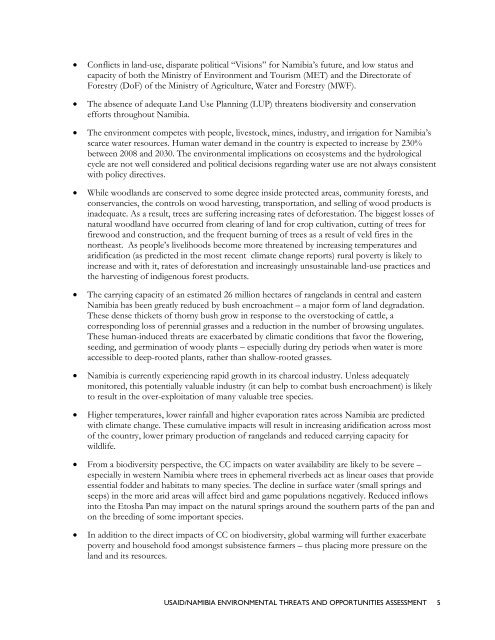usaid/nambia environmental threats and opportunities assessment
usaid/nambia environmental threats and opportunities assessment
usaid/nambia environmental threats and opportunities assessment
Create successful ePaper yourself
Turn your PDF publications into a flip-book with our unique Google optimized e-Paper software.
Conflicts in l<strong>and</strong>-use, disparate political “Visions” for Namibia’s future, <strong>and</strong> low status <strong>and</strong><br />
capacity of both the Ministry of Environment <strong>and</strong> Tourism (MET) <strong>and</strong> the Directorate of<br />
Forestry (DoF) of the Ministry of Agriculture, Water <strong>and</strong> Forestry (MWF).<br />
The absence of adequate L<strong>and</strong> Use Planning (LUP) threatens biodiversity <strong>and</strong> conservation<br />
efforts throughout Namibia.<br />
The environment competes with people, livestock, mines, industry, <strong>and</strong> irrigation for Namibia’s<br />
scarce water resources. Human water dem<strong>and</strong> in the country is expected to increase by 230%<br />
between 2008 <strong>and</strong> 2030. The <strong>environmental</strong> implications on ecosystems <strong>and</strong> the hydrological<br />
cycle are not well considered <strong>and</strong> political decisions regarding water use are not always consistent<br />
with policy directives.<br />
While woodl<strong>and</strong>s are conserved to some degree inside protected areas, community forests, <strong>and</strong><br />
conservancies, the controls on wood harvesting, transportation, <strong>and</strong> selling of wood products is<br />
inadequate. As a result, trees are suffering increasing rates of deforestation. The biggest losses of<br />
natural woodl<strong>and</strong> have occurred from clearing of l<strong>and</strong> for crop cultivation, cutting of trees for<br />
firewood <strong>and</strong> construction, <strong>and</strong> the frequent burning of trees as a result of veld fires in the<br />
northeast. As people’s livelihoods become more threatened by increasing temperatures <strong>and</strong><br />
aridification (as predicted in the most recent climate change reports) rural poverty is likely to<br />
increase <strong>and</strong> with it, rates of deforestation <strong>and</strong> increasingly unsustainable l<strong>and</strong>-use practices <strong>and</strong><br />
the harvesting of indigenous forest products.<br />
The carrying capacity of an estimated 26 million hectares of rangel<strong>and</strong>s in central <strong>and</strong> eastern<br />
Namibia has been greatly reduced by bush encroachment – a major form of l<strong>and</strong> degradation.<br />
These dense thickets of thorny bush grow in response to the overstocking of cattle, a<br />
corresponding loss of perennial grasses <strong>and</strong> a reduction in the number of browsing ungulates.<br />
These human-induced <strong>threats</strong> are exacerbated by climatic conditions that favor the flowering,<br />
seeding, <strong>and</strong> germination of woody plants – especially during dry periods when water is more<br />
accessible to deep-rooted plants, rather than shallow-rooted grasses.<br />
Namibia is currently experiencing rapid growth in its charcoal industry. Unless adequately<br />
monitored, this potentially valuable industry (it can help to combat bush encroachment) is likely<br />
to result in the over-exploitation of many valuable tree species.<br />
Higher temperatures, lower rainfall <strong>and</strong> higher evaporation rates across Namibia are predicted<br />
with climate change. These cumulative impacts will result in increasing aridification across most<br />
of the country, lower primary production of rangel<strong>and</strong>s <strong>and</strong> reduced carrying capacity for<br />
wildlife.<br />
From a biodiversity perspective, the CC impacts on water availability are likely to be severe –<br />
especially in western Namibia where trees in ephemeral riverbeds act as linear oases that provide<br />
essential fodder <strong>and</strong> habitats to many species. The decline in surface water (small springs <strong>and</strong><br />
seeps) in the more arid areas will affect bird <strong>and</strong> game populations negatively. Reduced inflows<br />
into the Etosha Pan may impact on the natural springs around the southern parts of the pan <strong>and</strong><br />
on the breeding of some important species.<br />
<br />
In addition to the direct impacts of CC on biodiversity, global warming will further exacerbate<br />
poverty <strong>and</strong> household food amongst subsistence farmers – thus placing more pressure on the<br />
l<strong>and</strong> <strong>and</strong> its resources.<br />
USAID/NAMIBIA ENVIRONMENTAL THREATS AND OPPORTUNITIES ASSESSMENT 5

















